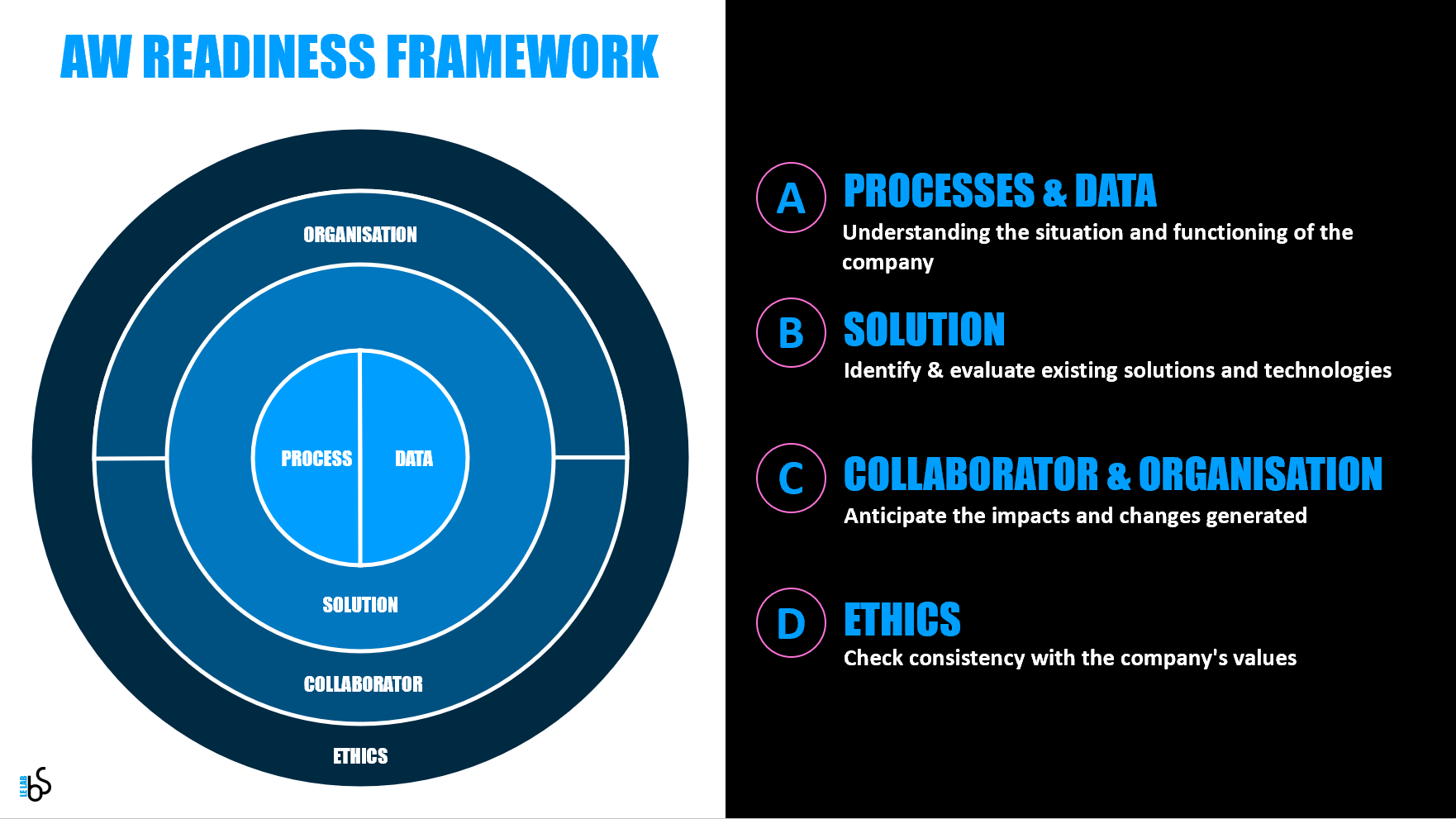4.3 Analysis grid
This is why the Bengs Lab has defined a panel of questions to ask before deploying an Augmented Worker solution. These questions are used to take a step back and include all the elements in the decision making process. Six themes are addressed: available data, existing processes, existing solutions, impacts on the worker, organisational impacts and ethical values.
This analysis grid is divided into 4 steps:
A. Process & Data
B. Solutions
C. Collaborator & Organization
D. Ethics

A. Process & Data
AVAILABLE DATA
First of all, you need to know what data is generated within the company. Make sure that the available data will allow to guarantee the quality of the Augmented Worker solution to be implemented. To do this, you must cover the existence of the data, its quality and its access and use rights. Example: the amount spent in the canteen every day per employee is available, but is not necessarily useful for the performance of the solution.
- Is the data necessary for the solution’s operation listed?
- How will new data be collected?
- Is the quality and quantity of the data recorded sufficient to guarantee the performance of the solution?
- What processes are in place to ensure that data quality is maintained?
- What is the impact of data quality degradation on the effectiveness of the solution?
- Does the solution use sensitive data? (Personal and confidential)
- Have your employees given their consent to use their personal data?
- Have the uses of the data been defined and communicated to your employees?
- Do you use data from other companies to improve the performance of your tools?
EXISTING PROCESSES
Evaluate the current situation of the company and its information systems in order to ensure the possibility of a solution deployment. To be optimal, the envisaged solution must integrate properly with the systems already in place. It must not disrupt the production chain, it must ensure the smooth running of the organization and the maintenance of good coordination between the different teams. Questions relating to tools and processes are :
- Which processes need to be reviewed in order to be improved?
- Are these processes applied homogeneously throughout the organization?
- Who are the main actors in the execution and governance of these processes?
- Are these processes digitalized?
- What are the objectives, qualitative and quantitative, of the Augmentation linked to these processes?
- How is measured the performance of these processes?
B. Solutions
The next step is to evaluate the suitability of Augmented Worker solutions. That is to say, to measure if these solutions can really solve the identified business problems. Researching similar needs in other industries can help identify these problems.
- A solution for which problem?
- What are the root causes?
- Is this the best solution available on the market to address your problem(s)?
- Do other companies have similar need(s)? If yes, which ones?
- Would a partnership be possible with these companies?
C. Collaborator & Organisation
IMPACTS ON THE WORKER
The employee is the first agent impacted by the implementation of innovative solutions. It is necessary to prepare for changes in working methods and to measure the impact of the work load and the direction of work.
- Is support provided to all employees to explain the reasons for future changes?
- Have you ensured that the employee’s commitment is maintained?
- Have the aspects of drudgery and workload been reviewed considering Augmented Worker technologies?
- Have you ensured that the division of labour between the AI system and employees allows for constructive interactions?
- Have you anticipated possible social impacts such as job loss or de-socialization of your employees?
- Have you identified an increase in the drudgery of work? (deletion of tasks, focus on high added value tasks …)
- Have the risks faced by employees been reassessed? (musculoskeletal disorders, psychosocial risks…)
ORGANIZATIONAL IMPACTS
Anticipating the organizational impacts of deploying Augmented Worker is essential to avoid any slippage in the company’s operating mode once the offer has been deployed. The focus is on the management, HR and performance levels to select the most appropriate offer.
- Have the impacts on the management line been anticipated, particularly for middle management?
- Have roles been redefined to fit the new organization? (division of tasks, coaching, performance monitoring, etc.)
- Is the segregation of responsibilities clear?
- Do you distinguish between Augmented Worker and non-Augmented Worker populations in your management of employees?
- What adjustments are planned in the recruitment and training processes?
- Do you plan to take Augmented Worker status into account in performance evaluation?
D. Ethics
Finally, after ensuring the feasibility of the solution within the company, one must ask whether the solution is ethically viable. That is, making sure that the processes to guarantee the freedom of action of the human worker are in place.
- Do you have a mechanism allowing people to report problems related to bias, discrimination or poor system performance?
- Have you ensured that processes are in place to facilitate auditability of the system by internal or external stakeholders?
- Does the worker know how decisions are made? (Traceability of the system, process to unblock in case of disagreement)
- Are workers aware of the gains obtained through the use of personal data?
- Did you involve workers and other stakeholders from the design phase of your solution?
- Is the solution designed so that the greatest number of people can use it? (Discrimination) Have you thought about the diversity of your users in the operation of the chosen solution?
- Have rules been defined to prevent misuse of your solutions?
- Have you evaluated the behaviour of your system in unexpected situations?
- Have you planned measures to ensure the integrity and resilience of the systems?
- Have you devised mechanisms to measure the environmental impact of the solution?